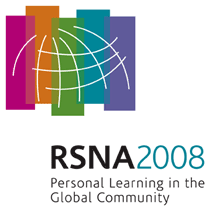
Abstract Archives of the RSNA, 2008
SSJ02-06
Ability of BIRADS 4A, B, and C to Stratify the Probability of Malignancy on Findings Undergoing Breast Biopsy
Scientific Papers
Presented on December 2, 2008
Presented as part of SSJ02: Breast Imaging (Multiple Modalities)
Jill Stein BS, Presenter: Nothing to Disclose
Karin Elisabeth Witte MD, Abstract Co-Author: Nothing to Disclose
Elizabeth S. Burnside MD, MPH, Abstract Co-Author: Stockholder, Cellectar, LLC
Lonie R. Salkowski MD, Abstract Co-Author: Nothing to Disclose
Gale A. Sisney MD, Abstract Co-Author: Nothing to Disclose
Kazuhiko Shinki, Abstract Co-Author: Nothing to Disclose
Jagpreet Chhatwal MS, Abstract Co-Author: Nothing to Disclose
Mary Lindstrom PhD, Abstract Co-Author: Research Consultant, F. Hoffmann-La Roche Ltd
et al, Abstract Co-Author: Nothing to Disclose
To prospectively evaluate whether the BI-RADS 4 assessment subdivisions (4A, 4B & 4C) stratify the probability of malignancy for mammographic abnormalities recommended for biopsy.
Data was collected on 458 consecutive biopsy recommendations in 383 patients age 30-95 (mean=57.4, SD=12.4) observed on diagnostic mammograms from October 2005-March 2007. Each mammogram was prospectively interpreted by one of eight radiologists (including 3 subspecialty trained breast imagers) using BI-RADS descriptors and an assessment category. Abnormalities warranting biopsy were given a single designation of 4, 4A, 4B, 4C, or 5. We excluded 62 (14%) abnormalities from analysis because tissue diagnosis was not available (40 deferred, 22 lost to follow-up). For the remaining 396 abnormalities in 337 patients, biopsy outcome (benign or malignant) was used to calculate the positive predictive value (PPV) of biopsy in each BI-RADS assessment. These PPVs were compared using the Chi-square test (with clustering to account for dependencies within patients).
BI-RADS categories were observed with the following frequencies: 4=99; 4A=128; 4B=85; 4C=39; and 5=45. The overall PPV of biopsy was 37.9%. The rates of malignancy in BI-RADS 4 (subdivisions not assigned) and 5 were 38.4% and 91.1%, respectively (p<0.0001). The rates of malignancy in abnormalities assigned the BI-RADS 4 subdivisions were: 4A=11.7%; 4B=30.6%; 4C=76.9% (p<0.0001). This trend was also preserved within abnormality types: specifically, the 109 masses demonstrated 4A=2.9%; 4B=41.7%; 4C=100.0% (p<0.0001), and the 239 microcalcification cases demonstrated 4A=15.7%; 4B=28.6%; 4C=62.5% (p=0.0185). Other abnormality groups were not sufficiently large to analyze. This same trend was seen for each radiologist, though the underlying PPV in each BI-RADS category varied to some degree. The average utilization rate of 4A, B, and C out of all BI-RADS 4 assessments was 71.8%, with radiologists ranging from 54.5-95.8%.
The 4A, B & C subdivisions introduced in the BI-RADS 4th edition are effective at predicting the probability of malignancy among suspicious lesions.
Stratifying BI-RADS 4 abnormalities may help radiologists convey the level of suspicion of a mammographic finding to both patients and their referring physicians.
Stein, J,
Witte, K,
Burnside, E,
Salkowski, L,
Sisney, G,
Shinki, K,
Chhatwal, J,
Lindstrom, M,
et al, ,
Ability of BIRADS 4A, B, and C to Stratify the Probability of Malignancy on Findings Undergoing Breast Biopsy. Radiological Society of North America 2008 Scientific Assembly and Annual Meeting, February 18 - February 20, 2008 ,Chicago IL.
http://archive.rsna.org/2008/6011968.html

